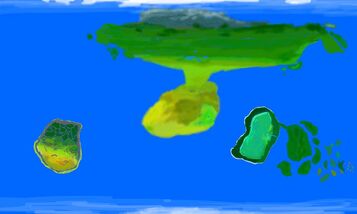Type: planet[]
Description:[]
Located in the Inner Tenebrarum arm. It is the 4th planet from the Aktar star, mild with varied climates. It is the homeworld of the Aktarians.
The gravity is slightly lower than Earth at 8.7 m/s2, and one day is about 1.5 Earth days.
The different biomes and ecosystems are incredibly varied, from alpine, rocky valleys, sprawling swamps and dense jungles.
Map:[]

A map of Aktar 4
Bintaway (leftmost continent in the map) is one of the most abstract places on the planet. In the north, giant "basin" canyons are home to giant, single leafed trees that are nearly as tall as the rocky borders that encompass them. 5-20m off the ground, a giant network of purple strand fungi simply called "The Net" weaves around the trees. 95% of life lives on or below it, either scurrying on the floor or in the network of underground rivers and caves. In the middle of the continent, rolling hills of strange algae like plants are one of the few lifeforms that can be found in the hostile windy environments. The south of the giant island is one large desert, inhabited by a handful of extremophiles.
North Cylo, the largest continent, features grasslands in the south, huge expanses of forest and steppes in the mid regions and one gigantic mountain range in the north. Animals in the forests and grasslands are similar to those that have lived on Earth in the present or past. In the mountains, you can find strange variations of animals further south, species with extra horns, a layer of fur or longer limbs for scaling mountainsides. Also in the mountains, around 200 million sapient avian creatures called Feathdacts live in tribes throughout the mountain river valleys. These are protected by the UCE and are even allowed to work in mining operations in the region.
South Cylo features a range of forests, grasslands, savannas, deserts, mountains, canyons and mesas. The biggest terrestrial animals live here, from the titanic six legged Quakreo to the dinosaur-like Prodonoe. The capital city of the UCE is here too, a metropolis sprawling over 200 kilometres.
Asio is one of the main reasons why the Aktarians advanced so quickly. On the outskirts of this island continent, you can find rocky plateau forests in the west, and jungles in the east. In the centre however, the land is filled with giant rock spires towering hundreds of metres into the sky. These rock spires are filled with oil that rises to the top in springs. This central region used to be an ancient sea, which is evident by the large amount of oil and the land that is several metres below sea level. In between the oil spires, the land is filled with exotic swamps and marshlands filled with strange plants and amphibious organisms. The Asioan cities are built around the edges of the rock spires above ground, with bridges connecting them.
Kincatee, features five main islands surrounding Kincat, the largest island. All are filled with dense jungle., and many species can be found that fit the same niches as jungle animals on Earth. The central archipelago features more varied environments with jungles, forests, scrublands and volcanic terrain, with the waters filled with tropical reefs. Animals are much more varied here depending on what island they live on and island dwarfism can be seen with species related to those on the main islands. The small collection of islands stretching into the ocean are one of the rarest phenomenon's in the galaxy. Most if not all of the organisms inhabiting these islands and the shallow waters around it have not changed for hundreds of millions of years. Fossils found elsewhere on the planet exactly match the living organisms on these "Time Locked Isles". Some of the organisms include the kingdom of life not found anywhere else on the planet, the Plastos; bodies and nervous/brain systems like animals but also use chloroplasts, thermoplasts, electroplasts etc. Due to the tectonic structure of the region it would be considered its own continent if it wasn't so small. The whole location is under strict protection by the Asioan Empire, and is still used for biological research today.
The huge oceans of Aktar 4 feature a whole range of undiscovered organisms, some creatures so large their calls can be heard halfway across the world when underwater.
